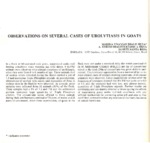Por favor, use este identificador para citar o enlazar este ítem:
http://www.alice.cnptia.embrapa.br/alice/handle/doc/514783Registro completo de metadatos
| Campo DC | Valor | Lengua/Idioma |
|---|---|---|
| dc.contributor.author | SILVA, M. U. D. e | pt_BR |
| dc.contributor.author | SILVA, A. E. D. F. da | pt_BR |
| dc.contributor.author | SANTA ROSA, J. | pt_BR |
| dc.date.accessioned | 2011-04-10T11:11:11Z | pt_BR |
| dc.date.available | 2011-04-10T11:11:11Z | pt_BR |
| dc.date.created | 1997-09-29 | pt_BR |
| dc.date.issued | 1982 | pt_BR |
| dc.identifier.citation | In: INTERNATIONAL CONFERENCE ON GOAT PRODUCTION AND DISEASE, 3., 1982, Tucson. Proceedings... Scottsdale: Dairy Goat Journal, 1982. p. 348. | pt_BR |
| dc.identifier.isbn | 0930848179 | pt_BR |
| dc.identifier.uri | http://www.alice.cnptia.embrapa.br/alice/handle/doc/514783 | pt_BR |
| dc.description | In a flock of 60 castrated male goats, maintained under stall feeding conditions since weaning age (112 days), 4 (6.6 percent) animals were observed with clinical symptoms of urolithiasis, when they were form 6 to 8 months of age. These animals died of uremia. Urine collected during the illnes showed a pH of 7.5 and numerous Triple Phosphate crystals. At post-mortem, obstruction of urethra with calculi and deposition of these in various sizes in the bladder were observed. As a result, urine samples were collected from 18 animals (30 percent) of the flock. These samples had a pH of 7.6 and 7.8 and the sedimented portion contained large quantities of Triple Phosphate crystals. The concentrate ration offered to these animals during their confinement consisted of 74 parts of maize and 26 parts of cottonseed. After these examination, all goats in the flock were put under a standard daily diet which consisted of 3 g of Ammonium Chloride (NH4Cl) per kg of concentrate mixed in the feed; 250 g of concentrate was given daily to each animal. This treatment appeared to have a market effects as no more clinical cases of animals showing symptoms of distressed urination were observed. Urine examination 10 days after the beginning of treatment showed that the pH had gone up to 8.0 to 8.1 and the sediment had very low, and almost normal, quantities of Triple Phosphate crystals. Further studies are continuing and are mainly directed at investigating the effects of maintaining goats under stall-fed conditions with and without medication for correcting urine pH and also to find out if feed composition has any relation to the heavy incidence of calculi formation | pt_BR |
| dc.language.iso | eng | eng |
| dc.rights | openAccess | eng |
| dc.subject | Urolitiase | pt_BR |
| dc.subject | Urolytiasis | pt_BR |
| dc.subject | Brasil | pt_BR |
| dc.title | Observations on several cases of urolytiasis in goats. | pt_BR |
| dc.type | Resumo em anais e proceedings | pt_BR |
| dc.date.updated | 2016-01-21T11:11:11Z | pt_BR |
| dc.subject.thesagro | Caprino | pt_BR |
| dc.subject.thesagro | Doença animal | pt_BR |
| dc.subject.thesagro | Cálculo urinário | pt_BR |
| dc.subject.thesagro | Rim | pt_BR |
| dc.subject.nalthesaurus | Goats | pt_BR |
| dc.subject.nalthesaurus | Animal diseases | pt_BR |
| dc.subject.nalthesaurus | Urinary tract diseases | pt_BR |
| dc.subject.nalthesaurus | Urinary calculi | pt_BR |
| dc.subject.nalthesaurus | Brazil | pt_BR |
| riaa.ainfo.id | 514783 | pt_BR |
| riaa.ainfo.lastupdate | 2016-01-21 | pt_BR |
| dc.contributor.institution | MARINA UNANIAN DIAS E SILVA, CNPC; ANTÔNIO EMÍDIO DIAS FELICIANO DA SILVA, CNPC; JANETE SANTA ROSA, CNPC. | pt_BR |
| Aparece en las colecciones: | Resumo em anais de congresso (CNPC)  | |
Ficheros en este ítem:
| Fichero | Descripción | Tamaño | Formato | |
|---|---|---|---|---|
| RACObservations.pdf | 313.2 kB | Adobe PDF |  Visualizar/Abrir |









